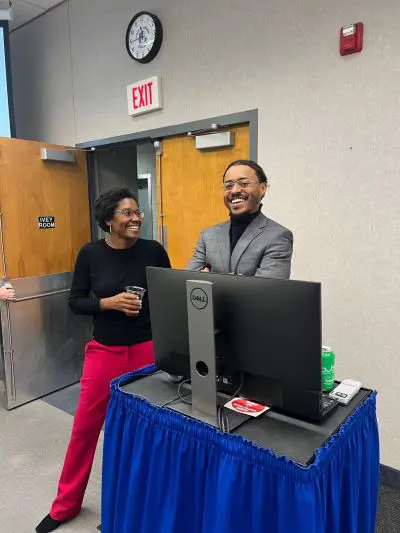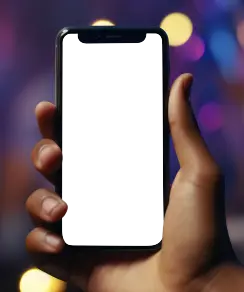On November 14, 2023, staff members from OCCRL met with the Illinois Community College Board’s Student Advisory Committee to discuss the function and utilization of open education resources (OER) at their institutions. Dr. Gianina Baker, the associate director for evaluation, learning, and equitable assessment at OCCRL, and Ayinde Rochon, an OCCRL research assistant, gave presentations to the elected student representatives from community colleges statewide.

The meeting provided student leaders with professional development opportunities and a chance to represent their school highlighting topics surrounding student life, experience, and advocacy. Melvin Harrison, who serves as the liaison between the Student Advisory Committee and outside professional development consulting organizations, moderated the session. Harrison is the director for academic affairs at the Illinois Community College Board. Prior OCCRL and student trustee sessions focused on surveying the racial campus climate at the students' respective institutions and overarching college life experience.
Student representatives were presented with definitions and examples of OER and contemplated their prevalence at the institutions they represent. As explained at the presentation, open education resources are “educational materials that can be remixed, reused, and shared that use a Creative Commons license or are available in the public domain and have no restrictions for free copyright. OER can range from supplemental content to entire textbooks.” Many scholars in attendance were aware of OER and how to access them within their university, a positive sign to the OCCRL team.
Rochon’s presentation, “Photovoice to Elevate College Affordability,” described photovoice as “a participatory method that provides research participants, who often may feel voiceless in society, the opportunity to reflect on their experiences and daily realities through photography. The issues documented in the photographs are then used as a catalyst to address community challenges” (Means et al., 2019, p. 143).
The overarching goal of photovoice in an academic setting is to provide a first-person view into the lives and experiences of the subject, building empathy and understanding surrounding voice and advocacy. Photovoice and OER go hand in hand by providing a visual aspect to data surrounding student life. Rochon explained that various forms of quantitative and qualitative data such as surveys and interviews are effective at capturing student voice; however, critical arts-based methods such as photovoice bring forth a visual aspect to the data, maximizing the effectiveness of research in the academy.
Previous scholars have explained the “goals of photovoice were achieved, namely to enable people, to record and reflect their community’s strengths and concerns, to promote critical dialogue and knowledge about personal and community issues through large and small group discussions of their photographs to reach policymakers” (Osei-Kofi, 2013; Wang, 1999, p. 185). Participants are often given cameras to document their experiences over an extended period of time, followed by journal entries to explain the photos and sentiments regarding them. The researcher then codes and analyzes the data and presents photos in a gallery walk for policymakers and administrators to engage, interact, and optimistically instill change.
Rochon utilizes photovoice in his own academic research by pairing it with the method of autoethnography to study Black college student experience at predominately white institutions. By analyzing journal entries, field notes, social media posts, and peer interviews collected by the practitioner, said data is coded into themes. These themes often relate to sense of belonging, faculty engagement, racial campus climate, familial relationships, faith, and more.
Rochon then attributes fine-art photographs, both abstract and direct, that embody the coded theme. For example, a barren cornfield outside of a college apartment can represent isolation and otherization. An image of a student with their peers playing basketball at the campus recreational center can represent student-curated sense of belonging. Photovoice solely amplifies the plethora of substantial research regarding Black student experience.
After debriefing the Student Advisory Committee on the method of photovoice, the student leaders participated in a 20-minute group discussion in which they selected a photo from their phones, one that embodied themselves and their college experience. Students shared images of people, places, and foods that gave viewers a direct look into their lives.
One example of a student-captured, discussed photo was an image in which a student photographed themselves in their science lab. In addition to the overt laboratory depiction of scientists, lab coats, and safety goggles within the image, the overarching message and what it embodied to the student meant much more. This image was an explicit representation of their determination to make it to this exact level in their academic journey. Surpassing electives and prerequisites, the student is now able to practice their skills tangibly. A testament and reminder for themselves, and anyone viewing, that they belong in this space and are looking forward to the future.
This activity generated empathy and understanding in a room that, formerly filled with colleagues, began to feel like family. It also demonstrated the potential impact the method of photovoice holds. Attendees were eager to discuss and learn how to utilize photovoice to advocate for student rights among policymakers and administrators at their institutions.
Formerly filled with colleagues, the room began to feel like family.
During the spring semester, Rochon will reconvene with the Student Advisory Committee to continue the discussion and engagement with photovoice among the student leaders, emphasizing and amplifying the voice they already hold. The time elapsed from the first meeting to the second will give the student leaders the opportunity to capture new photos, or select photos from their previous college experiences, and present, discuss, and analyze in a less abbreviated session. This meeting will be the follow-up to the brief introduction the students received prior in a workshop setting. The student trustees will be able discuss in further detail the method of photovoice and its effectiveness.
Watch or listen to the 2024 virtual OCCRL Equity Academy in which Ayinde Rochon presents a brief Photovoice session with participants.
Equity Academy webinar timestamp with Ayinde Rochon: 56:34
Equity Academy audio timestamp with Ayinde Rochon: 52:12
Resources
Means, D. R., Hudson, T. D., & Tish, E. (2019). A snapshot of college access and inequity: Using photography to illuminate the pathways to higher education for underserved youth. The High School Journal, 102(2), 139-158.
Osei-Kofi, N. (2013). The emancipatory potential of arts-based research for social justice. Equity & Excellence in Education, 46(1), 135-149.
